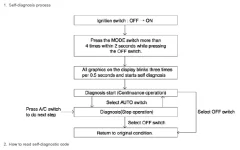Most of the A/C system is standard stuff any competent mechanic or A/C shop can service. Only the electronic control module needs dealer-style diagnostic tools. Common problems are temperature "blend" valves under/behind the dash; these are what modulate the temperature of the air coming through the vents. They are basically small electric motors and a few gears that move a door to direct airflow from the heater core or over the a/c evaporator core to your vents. If that gizmo jams then you get air from just one source. Most cars have a couple of these things today - one for each climate zone... and it's rare for both to fail at exactly the same time. If you have no a/c or heat on the driver side for example, but cold a/c air on the passenger side, then it's likely the driver side blend valve is bad. Interior temperature sensors and other sensors are used by the control module to know how much heat or a/c is needed; a failed temp sensor confuses the system.
A fairly simple test you can do yourself to see if the issue is the a/c mechanical bits under the hood or if it's somewhere in the control module, sensors, or dash actuators:
Open the hood. Look for silver-grey metal pipes about 1/4 to 1/2 inch in diameter going through the firewall (the metal wall dividing the engine area from the passenger area) and another that is larger - 3/4 to an inch in diameter. The small one will run from the a/c condenser (the a/c system radiator that sits between the bumper and the engine's much thicker radiator) and both may have rubber hose sections. They'll also have small plastic caps, about half to 3/4s inches in diameter, somewhere along the pipe. Those are the ports used to fill the refrigerant. Anyway, find the pipes near the firewall.
Start the engine, then set the a/c to max cool mode. Let the engine idle for a minute or so.
CAREFULLY touch the metal pipes close to the firewall. Or use a temperature gun (those gizmos stores/restaurants were using to measure your forehead temps during the Covid-19 years) to probe the temps of those pipes. The smaller diameter one should be pretty hot (so quickly touch it) and the larger one ice cold. If so, the a/c compressor and refrigerant are basically doing their jobs. If they are the same temperature - and close to the ambient air temperature - then the compressor is either not working at all, the clutch that turns it on/off under control module control is bad, or there is no refrigerant in the system due to a leak. Follow those pipes and look at each joint/junction in the pipe and at the rubber hose parts. If you find any greasy/wet areas you've found the refrigerant leak. Likely a green o-ring inside one of the joints has failed - a simple fix any a/c repair shop can handle as it is the most common problem. Joints where the rubber hoses attach to the metal hoses are another common failure point on any car a/c system... and a/c shops can replace that joint too.
Somewhere along the pipes you are likely to see a small metal box - on earlier model year cars it was bolted to the top/center of the firewall. This gizmo takes the high pressure refrigerant coming from the compressor and condenser coil and flashes it to a lower pressure which also makes the refrigerant flash to a very low temp. If it goes bad or gets blocked you will feel the inlet pipe is warm/hot and the outlet is not ice cold. Again, any a/c shop should be able to replace this part and recharge the refrigerant.
If you have a hot small pipe and ice cold large pipe at the firewall... then the a/c mechanical bits are working properly and the bug is in the under-dash air ducting and control mechanisms. Good a/c shops can handle this... it might be beyond regular mechanic shop capabilities as many don't like digging through the dash assembly. It's a lot of labor and a lot can get screwed up in the process: breaking plastic clips, failing to properly re-connect electrical connectors that had to be unplugged to take stuff apart, breaking old and brittle connectors, introducing new squeaks and rattles...
mike c.










